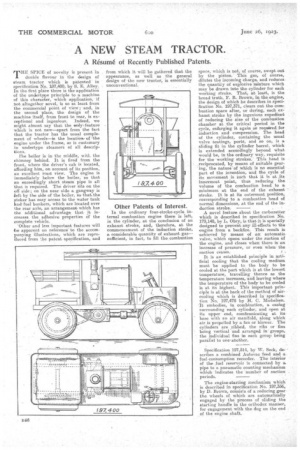A NEW STEAM TRACTOR.
Page 28

If you've noticed an error in this article please click here to report it so we can fix it.
A Résumé of Recently Published Patents.
THE SPICE of novelty is present in double flavour in the design of steam tractor which is patented in specification No. 187,400, by S. E. Alley, In the first place there is the application of the undertype principle to a machine of this character, which application, • if not altogether novel, is so al; least from the commercial point of view ; and, in the second place, the design of the machine itself, from front to rear, is exceptional and ingenious. Indeed, we might almost say that the enly4eature which is not new—apart from the fact that the tractor has the usual complement of wheels—is the location" of 'the engine under the frame, as is customary in undertype steamers of all descriptions.
The boiler is in the middle, with the chimney behind. It is fired from the front, where the driver's cab is located, affording him, on account, of its position, an excellent road view. The engine is immediately below the boiler, so that an esceedingly short steam pipe is all that is required. The driver sits on the off side; on the near side a gangway is 'eft, by the side of the boiler, so that. the stoker has easy access to the water tank hml fuel bunkers, which are located over the rear axle, an arrangement. which has the additional advantage that, it, increases the adhesive properties of the complete vehicle.
'Other and less important features will Le apparent on reference to the accompanying illustrations,, which are reproiluced from the patent, specification, and from which it will be gathered that the appearance, as well as the general design of the new tractor, is essentially unconventional.
Other Patents of Interest.
In the ordinary four-stroke-cycle internal combustion engine there is left, in the cylinder, at the conclusion of an exhaust stroke, and, therefore, at the commencement of the induction stroke, a considerable quantity of exhaust gas— sufficient, in fact, to fill the combustion
space, which is not, of course, swept out by the piaton.This gas, of course, dilutes the incoming charge, and reduces the quantity of explosive mixture which may be drawn into the cylinder for each working stroke. That, at least, is the broad truth. F. B. Brown, in the engine, the design of which he describes in specification No. 197,371, -clears out the combustion space after, or during, each exhaust stroke by the ingenious expedient of reducing the size of the combustion chamber at the critical period in the cycle, enlarging it again as required for induction and compression. The head of the cylinder, containing the usual valve seatings, ports, and so on, is a sliding fit in the cylinder barrel, which is extended accordingly beyond what would be, in the ordinary way, requisite for the working strokes. This head is .reciprocated, by means of suitable gear'lag, the nature of which is no essential part of the invention, and the cycle of its movement is such that it is at As innermost point, thus reducing the volume of the combustion head to a minimum at, the end of the exhaust, stroke. It is at its outermost position, corresponding to a combustion head of normal dimensions, at the end of the induction stroke. —
A novel feature about the carburetter which is described in specification No. 179,140, by L. Obry, is that it is specially designed to prevent any ill-effects to the engine from a backfire. This result is achieved by means of an automatic valve, which opens under the suction of the engine, and closes when there is an increase of pressure, or even when the suction ceases. ,
It is an established principle in artificial cooling that the cooling medium must be applied to the body to be cooled at the part which is at the lowest temperature, travelling thence as the temperature increases, and leaving where the temperature of the body to be cooled is at its highest. This important principle is at the back of the method of aircooling which is described in specification No. 197,478 by H. C. Michelson. 'It embodies, in combination, a casing surrounding each cylinder, and open at its upper end, cominunicating at its base with an air manifold, along which air is propelled by a fan or blower. The cylinders are ribbed, the ribs or fins being vertical and arranged in' groups, the individual fins in each group being parallel to one another.
Specification 197,514, by W. Seek, des • scribes a combined Autevac feed and a fuel-consumption recorder. The interior of the fuel reservoir is connected by a. pipe to a pneumatic counting mechanism which indicates the number of suction . periods.
The engine-starting mechanism which is described in specification No. 197,356, by D. Brown, consists of a reducing gear the wheels of which are automatically engaged by the process of sliding the starting handle in the orthodox manner, for engagement with the dog on the end of the engine shaft.




























